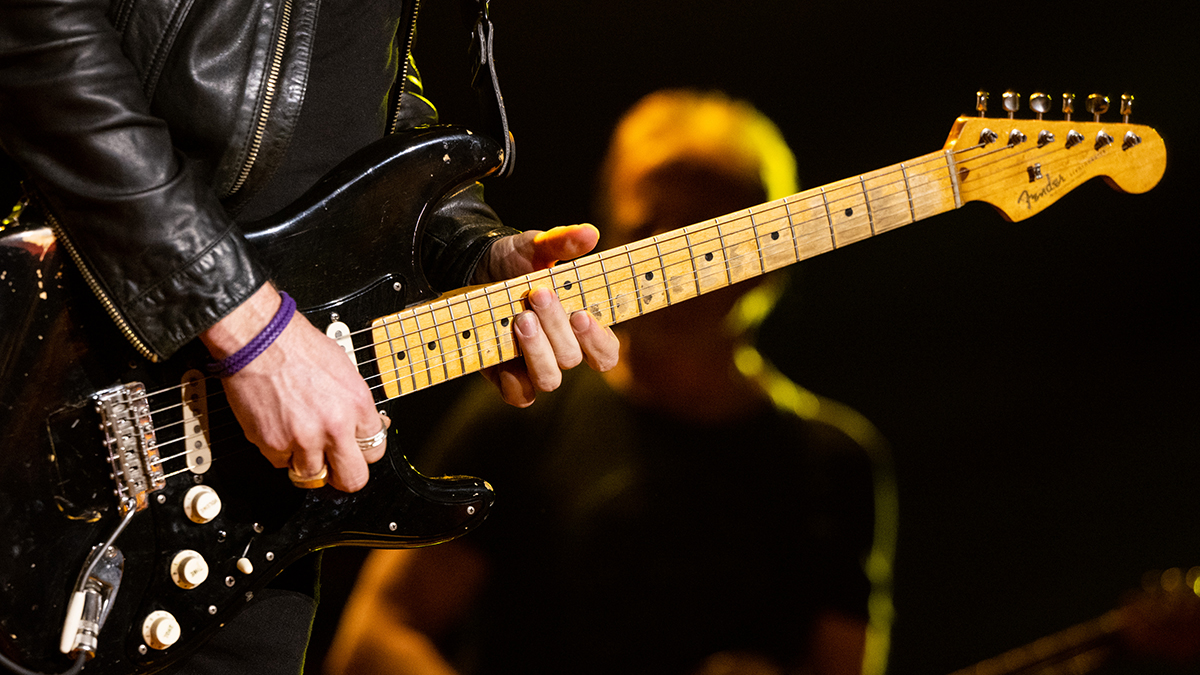Guitar lessons you can learn from Hank B. Marvin, instrumental guitar's first superstar and master of the whammy bar
Hank Marvin's melodic sensibility and mastery of dynamics is second to none, and this lesson takes you deep into a style that influenced some of the greatest players ever

Hank Marvin rose to fame in the late 1950s as the frontman for The Shadows. His blend of American rock and roll, country and surf based electric guitar work coupled with catchy songs full of melodic pop sensibility catapulted the band to mega success.
The Shadows also provided backing for British rock and roll mega star, Cliff Richard, and between them (together and as separate entities) amassed dozens of hit singles and albums.
The well-used phrase ‘the tone is all in the fingers’ is particularly relevant to Marvin. There is no overdrive to hide behind and the use of a clean tone from a Vox guitar amp combined with the bridge pickup can be particularly revealing if there are any technical glitches in the delivery.
Hank’s sound is of course the product of his consistency in terms of the way the notes are fretted and picked. However, the most obvious aspects of his style are his skilful manipulation of the vibrato arm combined with an ingenious use of tape echo.
The Meazzi Echomatic was the original tape echo machine that Hank used. This had multiple tape heads that produced his signature rhythmic echo. Rhythmic delays provide a cool ambience, but just as importantly add rhythm, especially to muted notes. This can be heard to great effect in songs like Wonderful Land.
In addition to whammy bar vibrato and multi-tap tape delay, Hank uses a huge variety of techniques to ‘sell’ the melodies; these include string bends, finger slides, volume swells, unison bends, palm muting, hammer-ons and pull-offs, double-stops and spread chords.
To help you to get into Hank mode, we have written and recorded three contrasting tracks designed to highlight various aspects of his Shadows-era style.
All the latest guitar news, interviews, lessons, reviews, deals and more, direct to your inbox!
The first is an upbeat offering in the style of tracks like Apache, Foot Tapper and Summer Holiday. The focus here is to help you develop the ability to bring those simple melodies to life with the use of whammy bar vibrato and echo. There is also an opportunity to try out using the palm muting technique to create that galloping, ‘scatter delay’ effect.
The second track is in the style of tunes such as Man of Mystery and Move It. There is also a chance to get stuck into some rock and roll-style soloing here. One of the key ingredients of this type of soloing is the use of double-stops, another Hank favourite.
For the third track, we slow things down for the obligatory ballad. This final performance number is inspired by tracks such as Sleep Walk and Wonderful Land.
Hank is fond of swelling into notes with a volume pedal, and this provides a really cool effect. The swell removes the attack from the note and provide a ‘violining’ effect when combined with the echo. There are some pretty intervals to explore in this track also, and Hank favours the 3rd and the 6th played sequential notes or as a double-stop.
Right! Grab your whammy bar, get plugged in and playing, and discover that this ‘simple’ stuff is not so simple after all!
Technique focus: whammy bar vibrato
Cliff Richard imported the first Fender Stratocaster into the UK for Hank to use, and this came equipped with the vibrato arm. Hank found the arm was an easier way to add vibrato to the heavy strings available at the time.
Hank keeps the vibrato arm cupped in his picking hand pretty much all the time he is playing a melody. This allows for those subtle shimmers to be added at will. Holding onto the arm does however restrict the picking hand’s movement.
You may need to experiment with the best way to maintain good picking while holding onto the bar. Hank holds the pick with the thumb and first finger and the end of bar sits in his lightly crooked third and fourth fingers.
A cool thing to try is the whammy bar scoop, achieved by depressing the bar and then allowing the strings to return to pitch. When the scoop is combined with the Hank’s multi-tap echo a cool, Doppler style effect is produced. If you are new to augmenting lead ideas with whammy bar vibrato and echo, why not try out some of our licks as an excuse to give it a go?
Get the tone
Amp settings: Gain 3, Bass 7, Middle 8, Treble 7, Reverb 3
Dial in a shimmering amp tone and add a compressor pedal (if you have one) for more sustain. If you don’t have a whammy-equipped guitar, try finger vibrato. Use the bridge pickup and set your delay with two or three repeats. If you can stack two delays, try 8th-note and dotted 8th-note combined. If you have a no volume pedal, try ‘violining’ with your guitar’s volume knob.
Piece 1. Surf pop style
[Intro] This first piece starts with a surf guitar inspired riff. To play the Eb notes use the fretting hand to depress the whammy bar by a semitone. This Duane Eddy style trick leaves the picking hand free to pick the quaver rhythm.
[Verse 1] This simple melody is augmented with whammy bar vibrato. Use the picking hand’s third and fourth fingers to lightly keep hold of the bar throughout. A subtle shimmer of vibrato is all that is required, so if you have a floating tremolo system use the lightest of touches or you’ll be out of tune.
[Verse 2] For this section, we get more mileage out of the melody by delivering it with palm muting. The palm muting helps to accentuate the delay repeats and this creates a chaotic, galloping rhythm that really creates excitement.
[Bridge] The bridge features the 3rd interval played in double-stops. This is inspired by tracks like Summer Holiday and On the Beach. Using finger slides to move position adds that extra bit of class and sophistication.
[Verses 3 and 4] These verses are repeats of verse 1 and 2, only this time we have shifted the key up a semitone for added excitement and expectation. The key change is a great way to create a lift at the end of a track.
[Outro] The outro is a repeat of the intro. This time however the notes are fretted as we don’t require the whammy bar to scoop the low notes.
Piece 2. Rock and roll style
[Intro] This track opens up with some full-sounding minor triad chords. These minor chords sound particularly effective in this style. Try spreading the chord strum out and you can also experiment with strumming nearer to the bridge. This will increase the treble and create more attack.
For the unison bends in bar 9, simply bend the second string up and allow it to clash with the fretted note on the first string (keeping it not quite in-tune makes for a great ‘unsettling’ sound.
[Guitar solo] This solo is inspired by tracks like Move It, and double-stops are the order of the day. The A minor pentatonic is the scale of choice and any of the notes, including adjacent notes outside the scale, can be played together to beef up the sound. The quarter-tone bend adds another slice of unsettling tension.
[Chorus 3 and 4] For this section, we play the arpeggios of the chords using a palm mute, with the pick ‘raking’ across the strings. It may take a bit of experimentation to get the palm mute even across the strings.
[Ending] For the ending we repeat the unison bends and rock and roll double-stops. Naturally, we raise the guitar vertically to the sky for the final notes!
Piece 3. Instrumental ballad style
[Main Theme] For our final piece, we’re slowing down the tempo. Hank often uses a volume pedal to swell into notes. This removes the guitar pick’s sharp attack and creates a more vocal sound. Hank used this in his brilliant version of Cavatina.
Jon Bishop is a UK-based guitarist and freelance musician, and a longtime contributor to Guitar Techniques and Total Guitar. He's a graduate of the Academy of Contemporary Music in Guildford and is touring and recording guitarist for British rock 'n' roll royalty Shakin’ Stevens.

